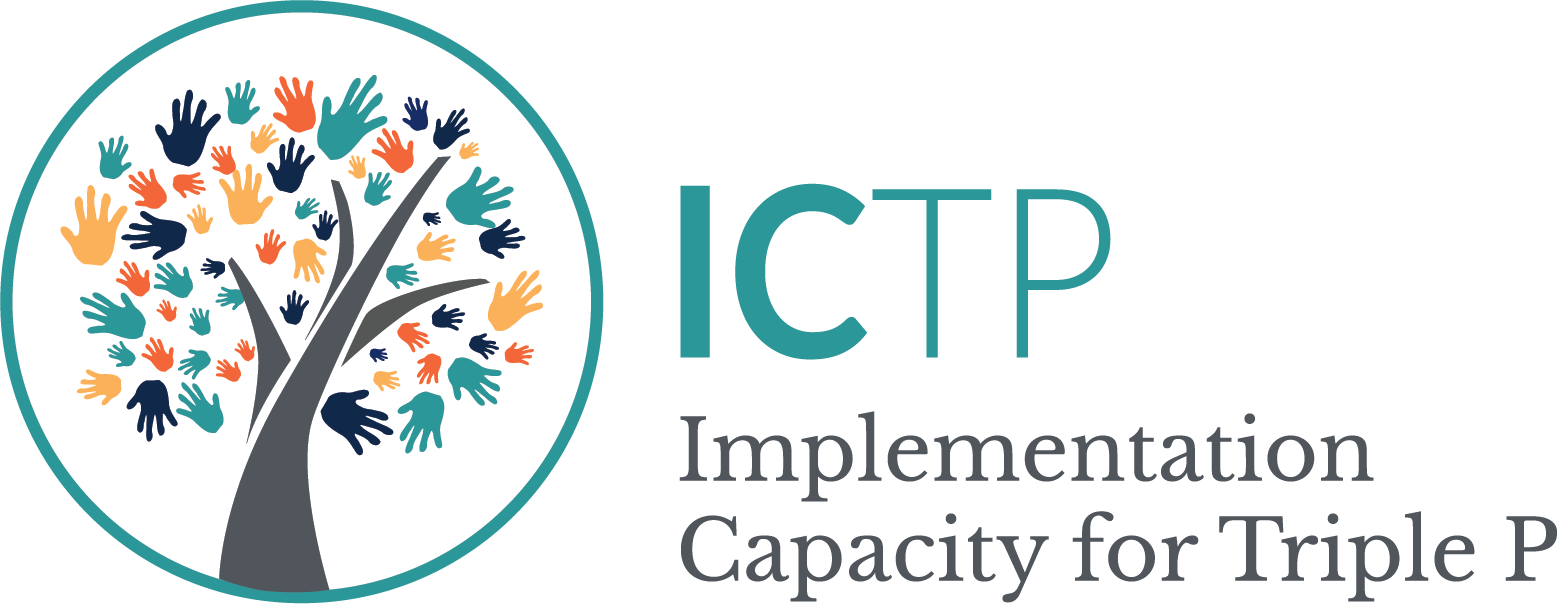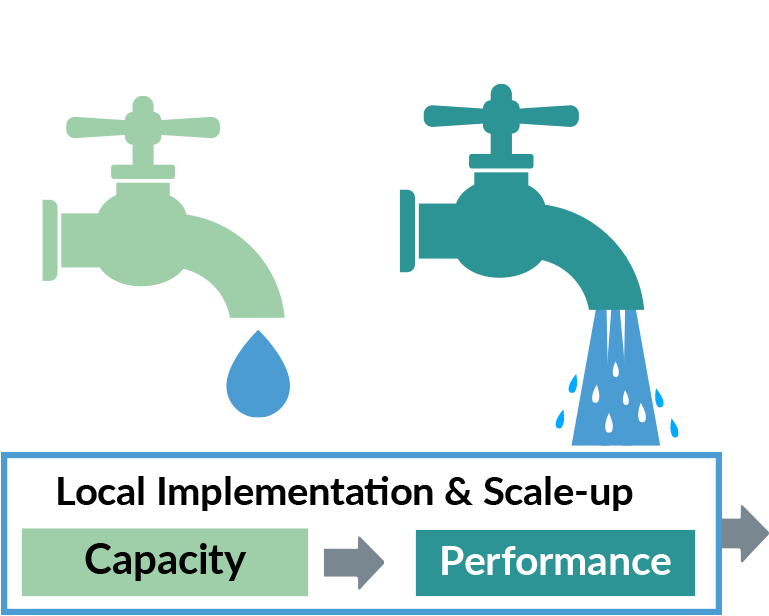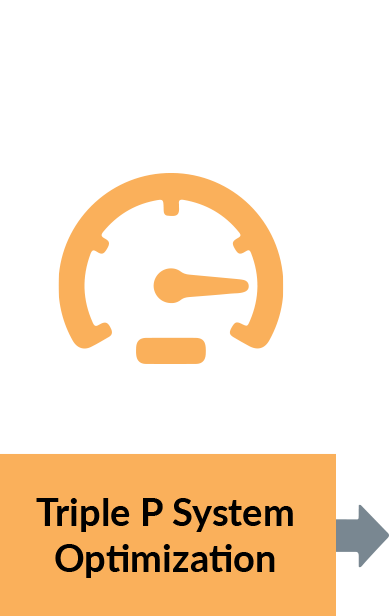The below logic model and associated resources are a part of the ICTP Implementation Support Plan for scaling Triple P. The purpose of the ICTP Implementation Support Plan and resources offered below are to guide and contribute to the collective actions of state and local Triple P coordinators, funders, policymakers, and technical assistance providers to meet and sustain statewide Triple P scale-up goals and intended family outcomes.
Click the icons in the logic model below to view associated learning modules, measures and other tools:
Co-Creation Partner Support
The development of local implementation capacity benefits from collaboration and active involvement among five sets of co-creation partners: 1) leadership and staff from implementing sites; 2) state/local funders and policymakers; 3) intermediary (e.g., NCIC-TP & SCIC-TP) and purveyor organizations (e.g., Triple P America) that provide implementation and program-specific support; 4) community parents, families, and other partners; and 5) researchers and evaluators. Together, co-creation partners combine valuable perspectives, resources, and abilities that increase the likelihood Triple P will be locally successful and sustainable.
Modules
Tools, Child Welfare & DSS
Local Implementation
Comprehensive Implementation Capacity & Performance
Leadership & Implementation Teams
Teams at each level of a community coalition (i.e., lead agency and service agencies) are sustainably organized, aligned, and resourced to provide leadership and management for successful Triple P implementation and scale-up. These teams install, manage, and sustain organizational and system practices that promote high quality Triple P delivery, identify and address Triple P implementation barriers, and recognize and spread Triple P implementation successes.
Workforce Development Systems
Workforce development plans for Triple P practitioner selection, training, and coaching are in place and integrate adult learning and coaching best practices. Workforce development activities and partners support the development of practitioners who are competent and confident to deliver Triple P as intended across diverse families and contexts.
Quality & Outcome Monitoring Systems
Data and information about Triple P implementation and delivery are collected, analyzed, reported, and used for decision-making to support continuous local quality improvement. Data and reports are widely shared and reach the right people at the right time in order to address timely needs and optimize Triple P programming over time.
Modules
Media & Networking Systems
For community-wide prevention and wellbeing efforts, media and networking strategies to mobilize knowledge and behavior change beyond that created by direct service interventions is important for achieving population-level outcomes. Media strategies promote normative information about child development, model positive parenting strategies, normalize the need for parenting support, and expand community awareness and accessibility to Triple P. Networking strategies accelerate the reach of Triple P and other positive parenting messages through key community organizations and individuals who are natural connectors across diverse community segments.
Triple P System Optimization
Population-level Outcomes
In a 2009 population trial of Triple P in South Carolina, results from 18 randomly assigned counties showed large effect sizes on three independently derived child and family outcomes:
- Substantiated child maltreatment
- Child out-of-home placements
- Child maltreatment injuries
The peer-reviewed research study, addendum, and other key research findings on the evidence base for Triple P can be found on Triple P’s website: https://www.triplep.net/glo-en/the-triple-p-system-at-work/evidence-based/key-research-findings/
State and local Triple P coordinators, funders, policymakers, and technical assistance providers may be interested in reviewing their own population-level data. To that end, ICTP has gathered some resources pertaining to each of the three child and family outcomes.
Please note that these child maltreatment indicators were “derived from archival data systematically and routinely collected and reported to the state data repository by hospitals, the foster care system, and the child protective services system” (Prinz et al. 2016), therefore local data reporting and availability may vary. To examine a reproducibility issue pertaining to the use of administrative data systems for evaluation of child maltreatment prevention, see Prinz 2017.
Data Definitions (Prinz et al. 2016)
Substantiated child maltreatment cases: “This indicator, which was generated by Child Protective Services (CPS) in each county and reported to a central data repository, included cases of substantiated (founded) CM for any child under age 8 years during the given year. A case could involve one or more than one type of maltreatment (e.g., physical abuse and neglect) but regardless of the number of maltreatment types/categories and the number of substantiation opportunities, no child was counted more than once in a calendar year; that is, the data were unduplicated.”
Child out-of-home placements: “This indicator, which was generated by the Foster Care System in each county and reported to a central data repository, was a count of children under age 8 years placed into foster care during the given year. No child was counted more than once in a calendar year.”
Child maltreatment injuries: “This indicator, which was generated by hospitals in each county and reported to a central data repository, included any hospital-treated injury or other medical condition that received an ICD code linked to possible CM and pertained to a child under age 8 years. Such cases came from both emergency room treatment and inpatient hospitalization. No child was counted twice in the same calendar year.”
North Carolina Data Sources
Substantiated child maltreatment cases and out-of-home foster care placement: Management Assistance for Child Welfare, Work First, and Food & Nutrition Services in North Carolina maintains a child welfare online database for the NC FAST data system. Investigative reports of abuse and neglect and number of children in custody data are available. County-level data can be accessed by entering the website through the main portal, http://ssw.unc.edu/ma/, selecting region, selecting “Child Welfare” tab on the side panel, and choosing indicator of interest.
Child maltreatment injuries (emergency department/hospital admissions): The North Carolina Disease Event Tracking and Epidemiologic Collection Tool (NC DETECT) is North Carolina’s statewide syndromic surveillance system. Authorized users can access data reported from hospitals and emergency departments across the state, including ICD-9/10 codes for child maltreatment injuries. See their Account Request page for more information on accessing this system.
Additional child maltreatment statistics: Prevent Child Abuse North Carolina houses a Child Maltreatment Statistics page, providing useful information about how North Carolina responds to suspected child abuse, statistics on statewide outcomes, facts about child fatalities in North Carolina, and the cost of child abuse and neglect.
Prinz, R. J. (2017). Assessing child maltreatment prevention via administrative data systems: A case example of reproducibility. Child abuse & neglect, 64, 13-18.
Prinz, R. J., Sanders, M. R., Shapiro, C. J., Whitaker, D. J., & Lutzker, J. R. (2016). Addendum to “Population-based prevention of child maltreatment: The US Triple P system population trial”. Prevention science, 17(3), 410-416.
Prinz, R. J., Sanders, M. R., Shapiro, C. J., Whitaker, D. J., & Lutzker, J. R. (2009). Population-based prevention of child maltreatment: The US Triple P system population trial. Prevention science, 10(1), 1-12.




